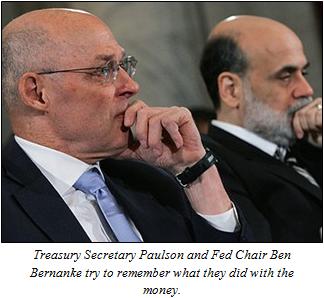
ALG Editor’s Note: As ALG News has previously reported, the Treasury’s Troubled Asset Relief Program has not been utilized to fulfill the tasks it originally was designed in the legislative process for, and as noted by the following featured editorial from Investor’s Business Daily, nobody seems to know where the TARP money has even gone:

Maybe the U.S. government really did have to abandon free-market principles to save the free market, as President Bush described the decision to spend hundreds of billions of dollars rescuing the economy from the financial crisis.
But if taxpayers really do have to shell out all that money as they see their neighbors — or even themselves — getting laid off and being foreclosed on, they should at least see how the money’s spent.
The incoming Obama administration can improve on this by pushing for more transparency and accountability. But will it?
So far, Hank Paulson’s Treasury Department hasn’t revealed how the bailout funds are being spent. It may be there’s such a sense of urgency at the federal level that action takes precedence over prudence. It’s not hard to understand why. Bush noted in his press conference Monday that he had “chucked” free-market principles because of fears the economy could fall into depression.
However, one of the key principles of those who want to shrink government, lower taxes and promote capitalism is that the people should know what government spends their taxes on.
If the purpose of the money given to banks was to ease foreclosures, then such strings should have been attached to the cash in the Treasury’s original strategy. It wasn’t.
On the other hand, if letting banks spend it as they wished was desirable, then Treasury should let it be known and defend it.
Instead of being straight up about things, however, we find Treasury answering questions from the Congressional Oversight Panel in a manner so tight-lipped that one would think the panel’s enquiries had been delivered to the National Security Agency by mistake.
This is not terrorist e-mails at issue; the government has little excuse for secrecy with so much tax money at risk.
The banks, too, have been tight-lipped about how they’re using the money. Given the amounts, this is not satisfactory.
One way or another, changes are on the way. President-elect Obama said Monday that he’ll seek stricter rules and more transparency in spending the remaining $350 billion of the $700 billion under the Troubled Assets Relief Program (TARP).
“I think many of us have been disappointed with the lack of clarity, the absence of transparency,” Obama said, after formally requesting that Bush ask Congress for the remaining $350 billion.
Already, Obama’s Treasury Secretary-designate Tim Geithner is working with Lawrence Summers, who’ll head the White House National Economic Council, to reshape TARP. They’re seeking to give the federal government a greater stake in financial firms, and to tie federal assistance explicitly to limits on executive pay.
House Banking Committee Chairman Barney Frank, D-Mass., whose advocacy of forcing banks to be instruments of social justice helped cause the mess we’re in, is also pushing TARP reforms that would impose “the most stringent nontax executive compensation restrictions” — including forbidding golden parachute payments to executives and applying executive pay limits retroactively.
Unfortunately, this is what the lack of transparency and no clear strategy for exactly how the rescue money would be used has set us up for: The micromanaging from Washington of the biggest financial institutions.
We wonder: How many other businesses will Uncle Sam end up setting executive pay for, outside the wishes of the shareholders?
There’s a very harsh lesson here. The TARP program came into being for the best of reasons. But it came up short when it comes to transparency. We’re glad Obama wants to make TARP better.
More transparency will surely help, but letting the federal government — which caused the problem in the first place — tighten its control over our financial system will bring us no good and may help slow our recovery.


